Student Blog
Classes
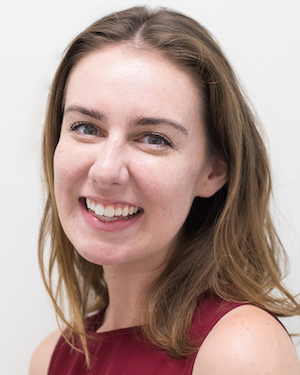
A Taste of Telehealth ⟩
April 8, 2020, by Noelle
Classes What are OS/OT?
This semester, I decided to take OT 574 Enhancing Motor Control for Occupation as one of my electives. While not super related to my interest in primary care, I chose it because I had previously enjoyed learning about motor control during the Adult Rehabilitation Immersion and thought it was a good idea to diversify my course load. What I was really drawn to though, was the chance to work with patients and refine my “therapeutic touch”. Trust me when I say that there is a huge difference between watching a demonstration or discussing a case study and actually being the one touching and working with a patient. You have to be confident, firm, but not too firm! It’s a really delicate balance that I was able to practice each week while mobilizing and facilitating movements with my client during the lab portion of this class.
This course was the definition of hands on learning. So when the move to online classes was made, I was very concerned and disappointed that I was no longer going to be able to see my client.
Luckily, my professors are experts in modifying tasks and coming up with creative solutions in their clinical work. Turning lemons into lemonade, they arranged for us to continue treating our clients through Zoom, allowing us to give telehealth a try. Given the hands-on nature of neurorehabilitation, there are limitations to what we can do remotely. But there are also a lot of things we can do.
So far, I’ve had two sessions with my client. My team and I are focused on designing a home exercise program that will reduce his abnormal tone and help keep him on track to making progress towards his goals. One of the advantages of using Zoom, is that we get to see his living environment “in person”. This helps us problem solve in real time around obstacles that he faces in doing some of the exercises and activities we recommend. I’m hopeful that we are making a well-tailored program for him.
There are challenges to this method. Sometimes it’s hard to see the specific movements through the camera, or it’s tricky to demonstrate and explain an exercise on a screen. But I am proud of the way both my team and our client are adjusting and making the most of the situation. This is a great exercise for us as OT students to think on our feet, be creative, adapt. Those are core skills to our profession, and I am thankful to be getting this experience and unique opportunity to practice them. Here’s to the silver linings!
For this week’s song rec, I’m sharing one of my all time favorites — “Video Killed The Radio Star” by The Buggles . . . fitting don’t you think?
⋯

Lifestyle Redesign®: From Theory to Reality ⟩
February 1, 2020, by Japeth
Classes
One of the many reasons why I came to USC is because of the Lifestyle Redesign® course elective. As an occupational therapy practitioner in my home country, I felt as though my role in targeting health and wellness promotion is still quite unclear. I knew that OTs have a huge role in such area, but to me, I just did not know where, when, and how I can advocate for myself in this field.
I learned about Lifestyle Redesign® — an approach in occupational therapy that allows clients to achieve health, behavior, or lifestyle changes — through a friend who also took this course years ago. Finally, this semester, I am taking this elective course and all I can say is it is just amazing! Dr. Dieterle teaches with so much passion and she makes sure that the class is interactive. The class flows this way:
- On the first day of this class, we started with a little introduction about ourselves and our reason for taking this course; during the second session and onwards, we start the class with a recap of last week’s session.
- Dr. Camille Dieterle will discuss the topic for the day. It could be about how to use different assessment tools or how to utilize specific strategies and intervention.
- We also get to practice this approach with our classmates. We are grouped into a triad and let’s name the students as A, B, and C. So, student A will be the therapist of student B; student B will be the therapist of student C; and student C will be the therapist of student A.
My therapist and I are now on our third week of session. During the first session, she interviewed me to create an occupational profile that was very holistic. During that session, I informed her about my adjustment with the new semester. I find this semester quite overwhelming, but still very manageable. We are working on a goal about rest and sleep, which includes creating a night routine.
I appreciate how my therapist gives so much attention to me and to my goal. She makes sure that every session that we have is interactive and client-led. She gives me worksheets about rest, sleep, and even drafting a routine. Last session, she gave a sleep checklist that I can fill up at night before I sleep and the morning after — this is to keep me in check!
Here’s to achieving a healthier mind and body this 2020!! Fight on!
⋯
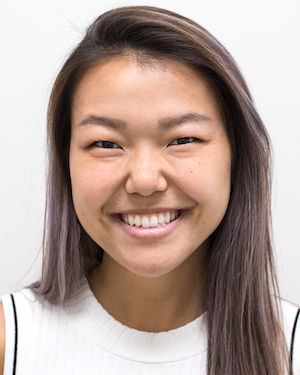
The 2020 (course) Elections ⟩
January 23, 2020, by Kaho
Classes
Welcome back everyone, and happy 2020! I hope you all had a restful and restoring winter break. I flew home to Japan for the full four weeks and I got to travel all over with my family. I spent some time in northern Japan, snowboarding and skiing in the snowy mountains, as well as in Japan’s southernmost tropical island, scuba diving and sightseeing! I feel like I experienced all four seasons in four weeks. Now I’m back in school, my jetlag has passed, and I am officially back on the grind. I’m beginning my last semester of classes for the master’s program, which means (as many of you may know) . . . electives! The Chan Division offers a wide variety of elective courses to choose from and these courses prepare you in specialty areas that you may want to pursue once you get out into the real world. You also have the option to take courses in other USC schools, such as the school of business, public policy, arts and sciences, etc. I’ll share with you today the courses that I’m taking, but past ambassadors have also written blog posts about what classes they took so be sure to check those out if you’re interested in learning more about what goes on in each class.
- OT 561: Occupation Therapy in Acute Care
For anyone interested in working in hospitals eventually or anyone interested in learning the more medical side of OT, this class is fantastic. This course goes over various systems of the human body and the implications for therapy when a person has issues in any of them. You get a sneak peek into the exciting and fast-paced life of an acute care OT and even get to observe it first hand through the clinical hands-on portion of the class! Similar to Level 1 fieldwork, you get paired with a clinical instructor at Keck Hospital and you get to follow them for several sessions throughout the semester. We learn the names of common illnesses and their treatments, medical devices, and so on. Even though I’ve only sat through two lectures for this course so far, I already know that it’s going to be one of my favorites. - OT 578: Therapeutic Communication for the Healthcare Practitioner
This course can be beneficial for anyone, regardless of what setting you’re interested in going into. You honestly don’t even have to be pursuing OT to benefit from this course. It trains you in a skill called Motivational Interviewing, which is a therapeutic communication style that can be used to facilitate change in clients. It also covers mindfulness practices, which can be a tool for myself as well in my own daily life. I know it’s going to make me a more effective communicator and a better listener for my friends, family, and clients so I’m really excited to learn more and practice. - OT 579: Occupation-Based Adult Neurorehabilitation
During my fieldwork experiences, I had the opportunity to work with several patients with spinal cord injuries and strokes. It can be devastating to lose function in your arms and legs and as you can imagine, OT can play a huge role in these people’s recoveries. This course teaches you and lets you practice various assessments that you may use in a neurorehab setting. We learn to analyze movement and consider how neurological impairments interfere with people’s ability to engage in meaningful occupations. It’s hands-on; students practice on each other while the professor demonstrates, and it’s all really interesting. As someone that wants to work in a variety of fields within the adult population, preferably in a hospital, this course supplies me with knowledge and skills that I know will come in handy during my career.
There are so many other classes that I was interested in taking, but time and the allowed number of units forced me to pick and choose. I’m enjoying all of my classes so far, so I know it’s going to be a fast, exciting semester. And then I graduate! 😮 Have a great semester, everyone.
⋯

New Year, New Challenges, But We Got This! ⟩
January 22, 2020, by Catherine
Classes Life Hacks
This is my first blog post of 2020 and it feels great to be back. The holidays are a magical time of the year, but my passion for occupational science and occupational therapy puts a little more pep in my step when I walk into CHP. And while we are talking about the subject of the new year, we cannot exclude the popular tradition of setting goals, resolutions for our self! I had an interesting discussion recently during my OT 649 course about health behavior change models and in particular, Social Cognitive Theory (SCT), that might provide you some insight if you feel that you are having trouble sticking to any resolutions of your own.
In short, SCT states that people are in charge of their lives and environment and can be motivated to overcome challenges through a positive sense of self efficacy. This theory can inform health promoting behavior change interventions in occupational therapy, and other health professions. In other words, we are taking about the just right challenge.
One of the requirements of during the first semester of the OTD program is to pass the NBCOT exam and become a certified occupational therapist. Trying to juggle my residency hours in preparation for the 2019 Occupational Science Symposium, attending class, and studying for the boards required a lot of balancing priorities and self-control. I did not think that I had the mental and physical capacity to achieve this goal. What got me through this time was the support from faculty, colleagues, and the overall sense of community I have always been provided here at Chan. This support allowed me to maintain a level of self-efficacy that motivated me to overcome my doubts and proactively push myself to close the gap of what I thought I could not do, and what I wanted to do. And according the SCT, self-efficacy is key.
Experiencing and overcoming the challenges of the Fall semester has enabled me to increase my sense of self-efficacy and will motivate me to challenge myself in this semester, and the next, until I achieve my long-term goal to obtain my OTD degree! So if you feel like you might not be able to keep up with your news year resolutions, find yourself a cheerleader, adjust the goal, tackle it in parts, instead of going to the gym 5 days a week, start with today. And then next time, your mind and body will know, if you did it once, you can do it again, and you will be better positioned to go twice a week, and then three times a week, until you ultimately reach your goal.
⋯
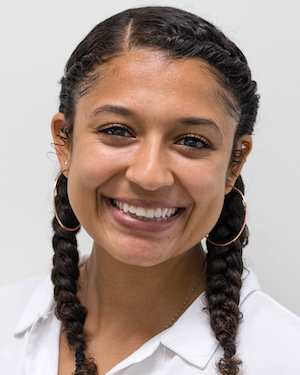
Electives and Field Trips ⟩
January 21, 2020, by Kat
Classes
Second semester of your second year in the OT program at USC is the freedom semester! This is when you are tasked with a difficult yet rewarding, complicated yet exciting, cut throat task of choosing . . . drumroll pleaseeee . . . your own electives!! Having the freedom to choose electives is kind of a double edged sword. There are so many great electives to choose from. There’s early intervention, acute care, motor rehab, to name a few. You can even opt to take elective courses on the main campus in other departments. Let’s say you are interested in running your own clinic one day, so maybe you take a business course. Second semester of your second year is meant for students to take lead in their learning and pursue topics and subjects that align with their interests and their future careers. If you are like me though, every class sounds interesting, which is why making a decision on what to take can be so difficult. There are still a few courses that are required, however, you get to choose how to fill up the rest of your credits.
Anywaysss . . . one of the classes I am taking right now is OT 571 Assistive Technology with Dr. Colin Lenington. Today in class we had the opportunity to go to Mobility Evaluation Program in the city of Bell where we met with individuals who specialize in helping people with disabilities be independent with their driving. During our field trip (Field trips in grad school? What??), my class and I were able to learn about some of the cool adaptive equipment that can be used to help people with varying disabilities to drive. If you think about it, driving is such an integral part of our everyday occupations, especially here in LA. It was such an eye opening experience for me. I had no idea this type of equipment was out there. As a class, we even had the opportunity to see the assistive tech we learned about in use with 2 clients that were there to demonstrate their personalized equipment.
I am not sure the specific realm of OT I want to go into yet. But I do know that I was blown away by the impact that helping someone with a task that I take for granted, driving, can have on an individual who navigates through the world differently than I do. Long story short, I am excited to see what else I learn in OT 571 Assistive Technology, along with my other courses. Cheers to an exciting semester . . . and to hopefully figuring out what area of OT I want to go into.
Check out my class and some assistive tech!
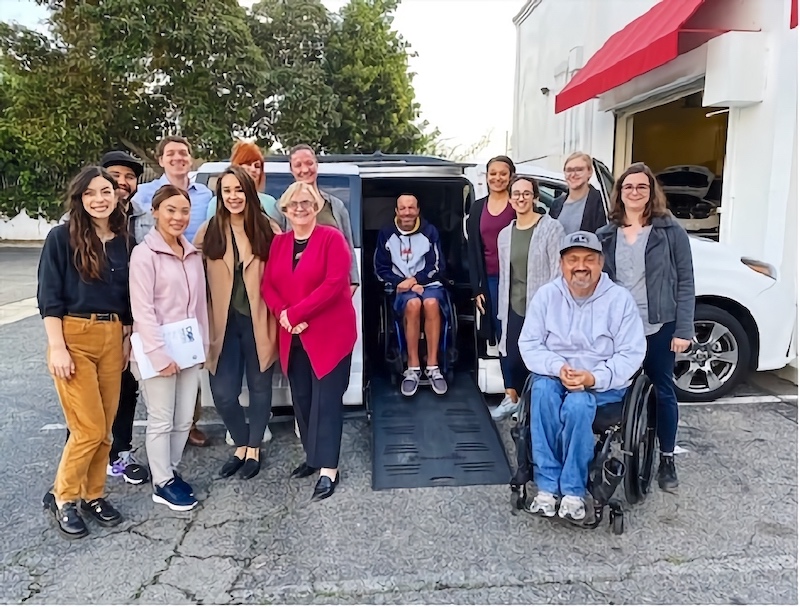
My Assistive Technology class with 2 clients that shared their experience with us. We are so grateful for their willingness to share with us! (Photo shared with permission from all individuals depicted)
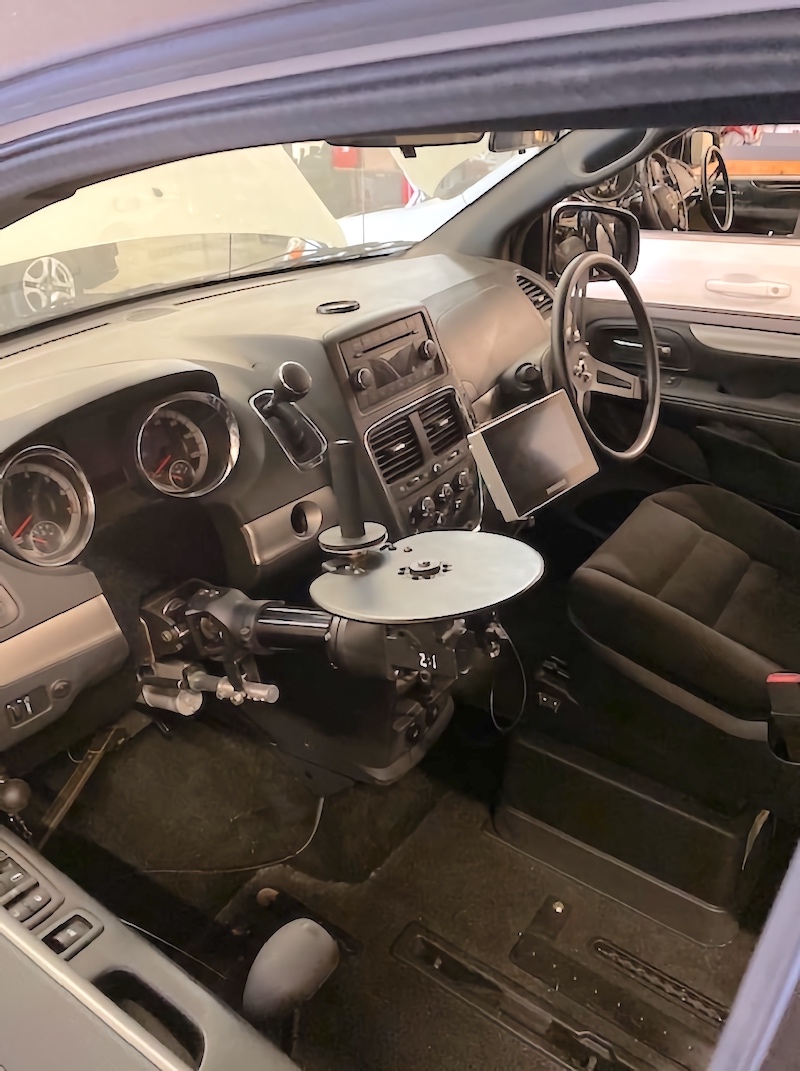
Here is an example of an adapted steering wheel a client may need to allow them to drive in a horizontal plane versus the “typical” vertical plane. This type of steering wheel is similar to what is seen on school buses. The steering is situated over the client’s lap as opposed to being mounted on the dashboard. On the floor of the car, you can also see where a wheelchair can be secured in place instead of the original car seat.
⋯





